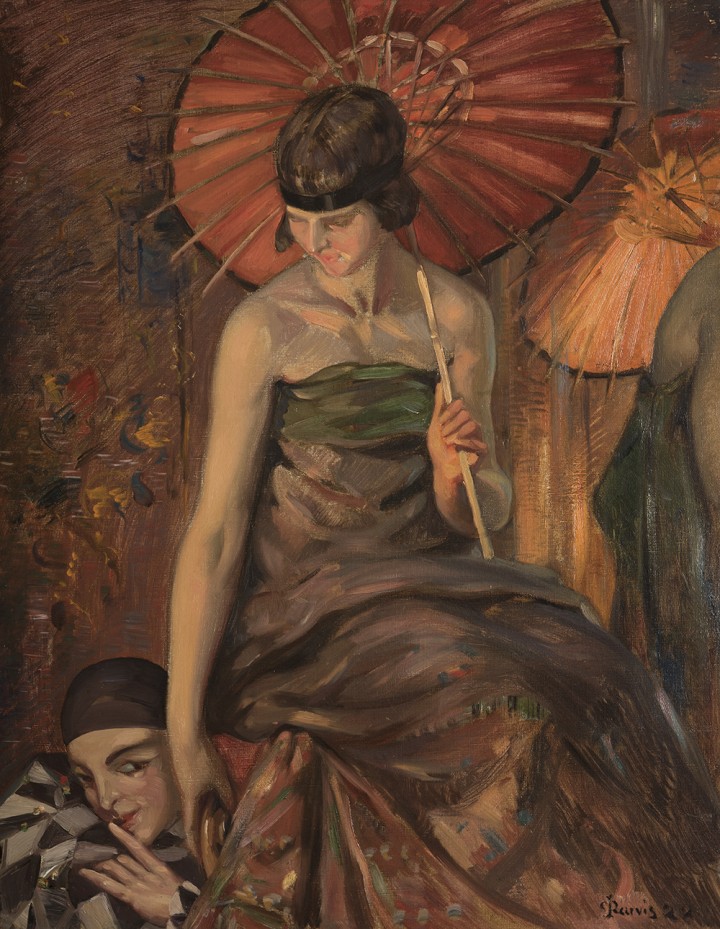Scottish Art News
Latest news
Magazine
News & Press
Publications
Lockdown Style Inspiration
By Alice Strang, 26.05.2020

Dorothy Johnstone’s Portrait of Cecile Walton of 1918 can lead the way in fashion for the outdoors, something we have not needed for months. Johnstone was born in Edinburgh and trained at Edinburgh College of Art where she later joined the teaching staff. She and Cecile Walton (1891-1956) became members of the Edinburgh Group exhibiting society.
In this celebration of their friendship, Walton is shown on a summer’s day, reclining amongst harvested hay. Her clothing symbolises her status as an emancipated woman. The brightly-striped skirt – or possibly more daring trousers – is worn above bright orange stockings. White brogues, a plain tunic and a lightly-patterned head scarf top and tail her ensemble. She looks relaxed, comfortable and stylish. What more could we wish for?
 Dorothy Johnstone (1892-1980), Portrait of Cecile Walton, 1918 © The Artist's Estate.
Dorothy Johnstone (1892-1980), Portrait of Cecile Walton, 1918 © The Artist's Estate.
Let us hope that our post-lockdown social life requires evening dress as chic as that in The Parasol and Pierrot of 1922 by John Purvis (1885-1961). Purvis was born in Perth and studied at Glasgow School of Art. He established a practice in Dundee and taught at what is now called Duncan of Jordanstone College of Art and Design in the city for virtually his entire professional life.
In this painting, a model with up-to-the-minute bobbed hair is shown in a daring off the shoulder gown. Its full-length design features a generous amount of material, depicted using broad, layered brushstrokes. They hint at colours from green to lilac as well as to the woman’s body underneath. Much is made of her uncovered skin, lit from our left by a suggestive low light. Her right arm reaches down to the head of a pierrot, there to provide entertainment. He holds a finger to his mouth, implying secrecy. In her left hand, the woman holds a parasol, a fashionable accessory with connotations of a more traditional femininity. It is seen from below and is also reflected in a passage at the far right which verges on the abstract. The atmosphere is at once enigmatic and enticing, just like the woman’s outfit.
 John Duncan Fergusson (1874-1961), La Terrasse, Dinard, 1931 © The Fergusson Gallery, Perth & Kinross Council.
John Duncan Fergusson (1874-1961), La Terrasse, Dinard, 1931 © The Fergusson Gallery, Perth & Kinross Council.
The Scottish Colourist John Duncan Fergusson’s La Terrasse, Dinard of 1931 provides tips for a summer wardrobe. Fergusson was born in Leith, near Edinburgh and had little formal training. He moved to Paris in 1907, cementing a lifelong love affair with France. This work was made in Brittany in the year the French state acquired one of his paintings, from a group exhibition of work by Scottish artists held at the Galerie Georges Petit in Paris.
Four women are seen on a terrace under bright sunshine. Loosely applied watercolour suggests light, full-length dresses, or long skirts and protective shawls. Areas of the white paper are left bare throughout to provide form, not least in their outfits. Rich tones of deep orange and blue suggest pattern and volume in the informal styling suited to high summer.
 Pat Douthwaite (1934-2002), The Red Cat, c. 1973. © The Artist’s Estate.
Pat Douthwaite (1934-2002), The Red Cat, c. 1973. © The Artist’s Estate.
Finally, Pat Douthwaite brings us to a more recent fashion era in her The Red Cat. Douthwaite was born in Glasgow and met Fergusson through attending classes run in the city by his partner, the dance pioneer Margaret Morris (1891-1980). He encouraged her to become a painter, but discouraged her from attending art school. She left Scotland in 1958 and spent much of her life abroad, before finally settling in Dundee. This painting is a pas de deux between the striking cat of the title and its female companion.
Simplification of form and flattening of space are extreme in a canvas which is two-thirds black. The eye is drawn to the stylized patterning of the woman’s long-sleeved shift dress. Rudimentary white flowers match her skin tone and give no hint of the body which they cover from rounded neck-line to just below the knee. The style is as sharp and unfussy as her haircut, neither feminine nor feminist but arresting in a way which does not depend on sexuality; this may be welcome after the home snacking and limited exercising of lockdown.
Alice Strang is a Curator and Art Historian of Modern and Contemporary Art




